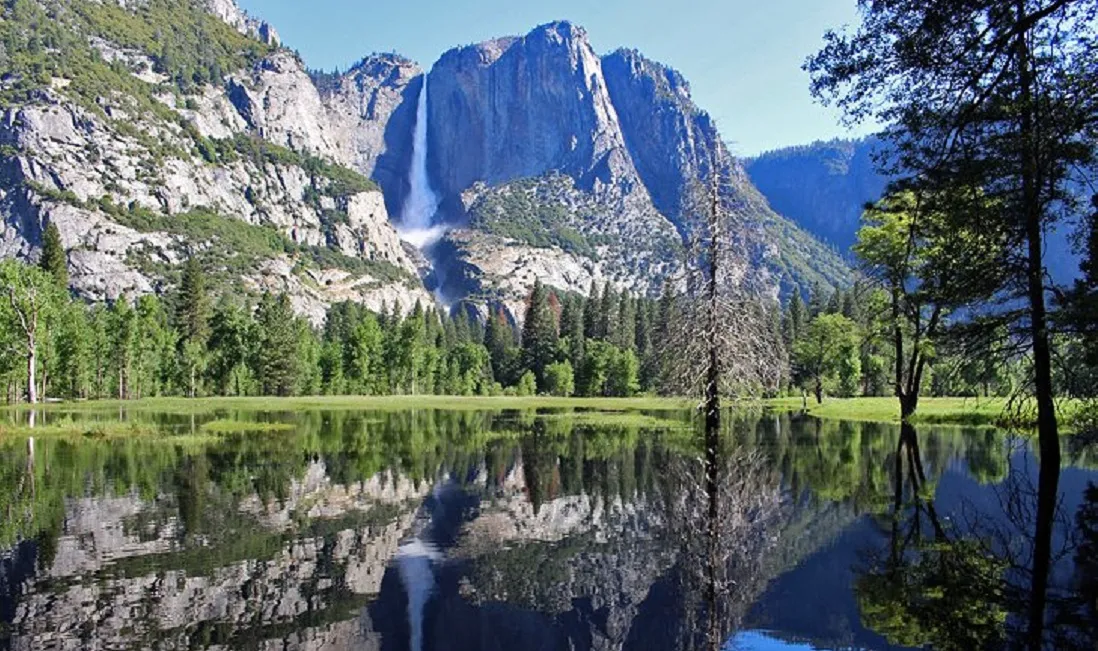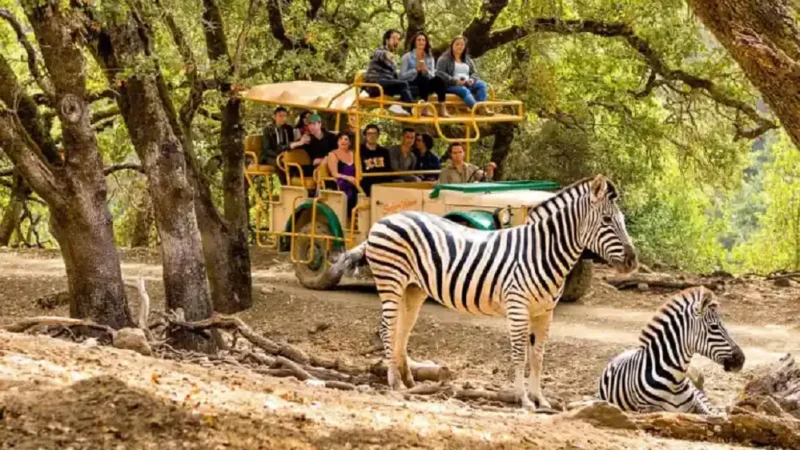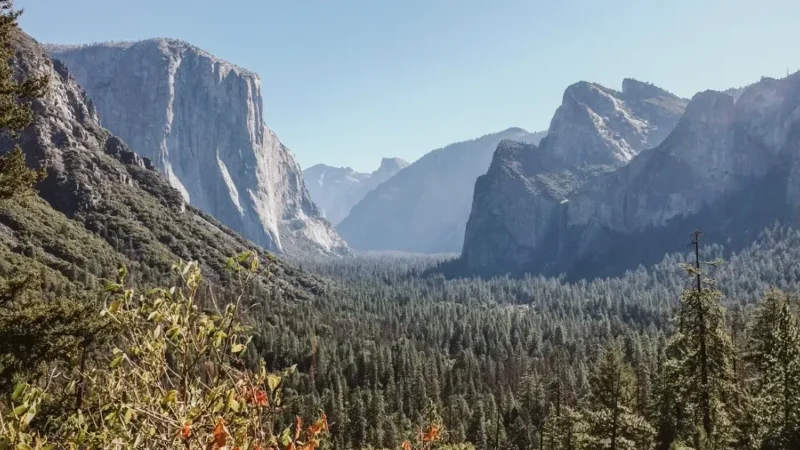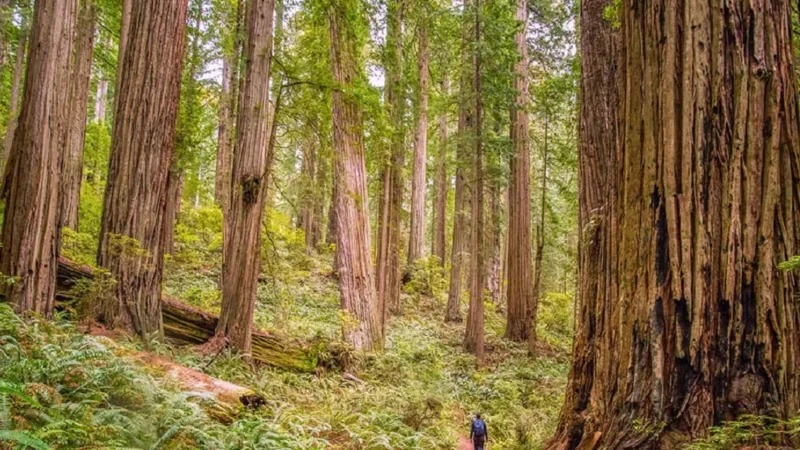Top 14 National Parks in California

Table of Contents
ToggleBest National Parks in California -
California, a land of astounding beauty and diverse landscapes, is home to some of the most breathtaking national parks in the United States. From the majestic mountains to the rugged coastline, these protected areas offer an escape into nature’s wonderland. In this blog, we will embark on a virtual journey through California’s finest national parks, delving into their unique features, awe-inspiring landscapes, and the incredible experiences they offer visitors. So, fasten your seatbelts and get ready to explore the pristine wilderness and natural treasures of the Golden State!
1- Yosemite National Park
Yosemite National Park is one of California’s most iconic and beloved national parks and the entire United States. Here are some key details about Yosemite National Park:
Location: Yosemite National Park is located in the Sierra Nevada Mountains of Central California, covering an area of over 748,000 acres.
Natural Features: The park is renowned for its breathtaking natural beauty, which includes granite cliffs, towering waterfalls, pristine lakes, meadows, and ancient giant sequoia trees. Yosemite Valley, carved by glaciers, is a prominent feature of the park and is home to iconic landmarks like Half Dome and El Capitan.
Waterfalls: Yosemite is famous for its spectacular waterfalls. Some of the notable waterfalls within the park include Yosemite Falls, the tallest waterfall in North America, Bridalveil Fall, Vernal Fall, and Nevada Fall.
Giant Sequoias: The park has several groves of giant sequoia trees, including the Mariposa Grove, where visitors can marvel at these enormous and ancient trees.
Outdoor Activities: Yosemite offers many outdoor activities, making it a paradise for enthusiasts. Visitors can enjoy hiking, rock climbing, camping, fishing, horseback riding, cycling, winter skiing, and snowshoeing.
Scenic Drives: The park features several scenic drives that offer stunning views of its landscapes, including the famous Tioga Road, Glacier Point Road, and the drive through Yosemite Valley.
Wildlife: Yosemite is home to a diverse array of wildlife, including black bears, mule deer, coyotes, bobcats, and various bird species. It provides opportunities for wildlife watching and birding.
Visitor Centers and Facilities: Yosemite National Park has several visitor centers that provide information, exhibits, and educational programs. The park offers various accommodation options, including campgrounds, lodges, and cabins.
Conservation and Protection: Yosemite has a rich conservation history and is recognized as a UNESCO World Heritage Site. Efforts are made to preserve its natural beauty, ecosystems, and cultural heritage.
2- Joshua Tree National Park
Joshua Tree National Park is a unique desert oasis located in Southern California. Here are some key details about Joshua Tree National Park:
Location: Joshua Tree National Park is in southeastern California, covering an area of approximately 800,000 acres. It lies at the intersection of the Colorado Desert and the Mojave Desert.
Joshua Trees: The park comes from the iconic Joshua trees (Yucca brevifolia) that dot the landscape. These unusual-looking trees with spiky branches are native to the region and symbolize the park.
Distinctive Landscapes: Joshua Tree National Park boasts a diverse and striking desert landscape. It features vast expanses of Joshua tree forests, rugged rock formations, granite monoliths, sandy washes, and vast desert plains. The unique geological formations, such as Hidden Valley and Jumbo Rocks, are popular among hikers and climbers.
Wildlife: Despite the harsh desert environment, the park supports many wildlife. Visitors may spot desert bighorn sheep, coyotes, kangaroo rats, jackrabbits, and bird species. The park is also known for its diverse desert flora, including cacti, yuccas, and wildflowers that bloom during the spring.
Outdoor Activities: Joshua Tree offers numerous outdoor activities. The park has an extensive network of hiking trails, ranging from short nature walks to challenging backcountry treks. Rock climbing is another popular activity, attracting climbers worldwide due to its unique rock formations. Additionally, the park is great for stargazing, as it has some of the darkest skies in Southern California.
Cultural and Historical Sites: Joshua Tree National Park has a rich cultural and historical heritage. It is home to remnants of early human habitation, Native American petroglyphs, and historic ranches that tell the story of the region’s past.
Visitor Centers and Facilities: The park has several visitor centers that provide information, exhibits, and educational programs. Campgrounds and picnic areas are available for visitors who wish to explore the park more.
Conservation and Protection: Joshua Tree National Park is dedicated to preserving its fragile desert ecosystem. Efforts are made to protect its unique plant and animal species and its cultural and historical resources.
3- Redwood National and State Parks
Redwood National and State Parks are a collection of protected areas located along the northern coast of California. Here’s some information about Redwood National and State Parks:
Location: The parks are situated on the coast of northern California, covering an area of approximately 139,000 acres. They extend from Crescent City in the north to Orick in the south.
Ancient Redwood Forests: The parks are renowned for their majestic coast redwood trees (Sequoia sempervirens), some of Earth’s tallest and oldest trees. These massive trees can reach over 300 feet and live for thousands of years.
Scenic Landscapes: Redwood National and State Parks offer diverse and scenic landscapes. Visitors can explore ancient forests with towering redwoods, lush fern canyons, meadows, rivers, and rugged coastal areas.
Fern Canyon: One of the highlights within the parks is Fern Canyon, a narrow gorge adorned with various ferns clinging to its vertical walls. The canyon has been featured in several films due to its enchanting beauty.
Wildlife: The parks are home to a variety of wildlife species. Visitors may encounter Roosevelt elk, black bears, mountain lions, bobcats, gray foxes, and numerous bird species. Marine life, including whales, seals, and sea lions, can also be seen along the coast.
Trails and Outdoor Activities: Redwood National and State Parks offer an extensive network of trails for hiking, allowing visitors to immerse themselves in the ancient redwood forests. Additionally, there are opportunities for camping, fishing, kayaking, and wildlife watching.
Visitor Centers and Educational Programs: The parks have visitor centers that provide information about the area’s natural and cultural history. Educational programs and ranger-led activities are available to enhance visitors’ understanding and appreciation of the parks.
Conservation and Preservation: Redwood National and State Parks are dedicated to conserving and preserving ancient redwood forests. The parks aim to protect these ecosystems and the species that depend on them, allowing visitors to experience and appreciate their beauty.
4- Sequoia and Kings Canyon National Parks
Sequoia and Kings Canyon National Parks are two contiguous parks in California’s southern Sierra Nevada Mountains. Here’s some information about Sequoia and Kings Canyon National Parks:
Location: The parks are in central California, east of the San Joaquin Valley. Sequoia National Park lies to the south, while Kings Canyon National Park is to the north. Together, they cover an area of over 1,353 square miles.
Giant Sequoia Trees: The parks are renowned for their giant sequoia trees (Sequoiadendron giganteum). These ancient and colossal trees are among the largest living organisms on Earth. The General Sherman Tree in Sequoia National Park is the most giant known tree by volume.
Scenic Landscapes: Sequoia and Kings Canyon National Parks offer diverse and stunning landscapes. Visitors can explore deep canyons, granite peaks (including Mount Whitney, the highest peak in the contiguous United States), alpine meadows, and roaring rivers. The parks also contain impressive underground cave systems.
Kings Canyon: Kings Canyon, located in Kings Canyon National Park, is one of the deepest canyons in North America, known for its towering granite walls and picturesque vistas.
Outdoor Activities: The parks provide abundant opportunities for outdoor activities. Visitors can enjoy hiking on vast trails, including the famous High Sierra Trail and Pacific Crest Trail. Camping, fishing, backpacking, rock climbing, horseback riding, and winter activities such as snowshoeing and cross-country skiing are also popular.
Wildlife: The parks are home to diverse wildlife, including black bears, mule deer, bighorn sheep, coyotes, bobcats, and numerous bird species. The rivers and lakes support trout populations, attracting anglers.
Crystal Cave: Located in Sequoia National Park, Crystal Cave is a beautiful marble cavern that offers guided tours, allowing visitors to explore its intricate formations, stalactites, and stalagmites.
Visitor Centers and Facilities: The parks have visitor centers that provide information, exhibits, and educational programs about the natural and cultural history of the region. Campgrounds, lodges, and picnic areas are available for visitors to stay and enjoy the parks.
5- Death Valley National Park
Death Valley National Park is a vast and unique desert park in eastern California. Here’s some information about Death Valley National Park:
Location: Death Valley National Park is situated in the Mojave Desert in eastern California. It stretches across parts of Inyo County and Nye County, Nevada. It is the largest national park in the contiguous United States.
Extreme Landscapes: Death Valley is known for its extreme landscapes and harsh desert environment. It features salt flats, dunes, rugged mountains, canyons, and unique geological formations. Badwater Basin, the lowest point in North America, is located in Death Valley.
Badwater Basin: This salt flat is one of the park’s iconic features. Visitors can walk out onto the vast expanse of salt, and it offers breathtaking views of the surrounding mountains.
Mesquite Flat Sand Dunes: These expansive dunes are a popular attraction in the park. They provide a surreal desert experience and are stunning at sunrise or sunset.
Artist’s Palette: Located in the Black Mountains, the Artist’s Palette is a colorful geological formation where the minerals in the rocks create vibrant hues of red, pink, yellow, and green.
Furnace Creek: Furnace Creek is the main visitor area within Death Valley National Park. It offers accommodations, restaurants, visitor centers, and campgrounds.
Scotty’s Castle: While not a castle, Scotty’s Castle is a historic house and museum located in the northern part of the park. It provides insights into the park’s history and the eccentric character, Walter Scott, who claimed to have built the castle.
Outdoor Activities: Despite its extreme environment, Death Valley offers various outdoor activities. Visitors can explore hiking trails, scenic drives, camp, stargaze, and photograph the unique landscapes. The park also provides opportunities for off-roading, birdwatching, and exploring ancient rock art sites.
Wildlife and Plants: Death Valley is home to a surprising variety of desert wildlife, including coyotes, kit foxes, roadrunners, and bighorn sheep. The park’s flora includes desert plants such as Joshua trees, cacti, and wildflowers that bloom after rare rains.
6- Channel Islands National Park
Channel Islands National Park is a collection of five remarkable islands off the coast of Southern California. Here’s some information about the Channel Islands National Park:
Location: Channel Islands National Park is located off the coast of Ventura and Santa Barbara counties in Southern California. The park encompasses five Channel Islands: Anacapa, Santa Cruz, Santa Rosa, San Miguel, and Santa Barbara.
Island Biodiversity: The park is renowned for its rich biodiversity and unique ecosystems. It is home to various plants and animals, including several endemic species found nowhere else on Earth. The marine environment surrounding the islands is teeming with marine life, making it a popular destination for diving and snorkeling.
Island Hiking and Camping: Each of the islands in the park offers hiking trails that allow visitors to explore its scenic landscapes, including rugged coastlines, cliffs, and canyons. Primitive camping is available on some islands, providing overnight stays and extended exploration opportunities.
Kayaking and Boating: Kayaking is a popular way to explore the sea caves, kelp forests, and pristine coastal waters surrounding the islands. Visitors can also take boat tours and cruises to experience the park’s beauty and potentially spot marine wildlife such as dolphins, seals, and whales.
Wildlife Watching: Channel Islands National Park is home to diverse wildlife. Visitors may encounter island foxes, harbor seals, sea lions, pelicans, seabirds, and various species of marine life. The park is also an important breeding ground for seabirds, including the California brown pelican.
Archaeological and Cultural Sites: The islands have a rich cultural and historical heritage. Visitors can explore ancient Native American village sites, rock art, and historic ranching and fishing remnants.
Visitor Centers and Education: The park has visitor centers on the mainland that provide information, exhibits, and educational programs about the park’s natural and cultural resources. The centers offer insights into the park’s unique ecosystems, wildlife, and conservation efforts.
7- Lassen Volcanic National Park
Lassen Volcanic National Park is a scenic and geologically active park located in northeastern California. Here’s some information about Lassen Volcanic National Park:
Location: Lassen Volcanic National Park is situated in the Cascade Range of northeastern California. It encompasses an area of over 106,000 acres.
Volcanic Activity: The park is known for its geothermal features and active volcanoes. Lassen Peak, the largest plug dome volcano in the world, is a prominent feature and stands at over 10,000 feet (3,189 meters) in elevation. The park also has other volcanic features such as fumaroles, mud pots, hot springs, and volcanic gas vents.
Geothermal Areas: Bumpass Hell, located in the park, is a famous hydrothermal area with boiling mud pots and steaming fumaroles. It provides visitors with an up-close look at the geothermal activity in the park.
Lassen Peak Summit: Hiking to the summit of Lassen Peak is a popular activity for visitors. The trail offers stunning views of the surrounding landscapes, including volcanic craters, mountain lakes, and forests.
Hiking and Outdoor Activities: Lassen Volcanic National Park offers numerous hiking trails that allow visitors to explore its diverse landscapes, including meadows, forests, and volcanic features. Other activities include camping, fishing, wildlife watching, and snowshoeing or cross-country skiing in winter.
Manzanita Lake: Manzanita Lake is a picturesque lake near the park’s entrance. It provides opportunities for fishing, kayaking, canoeing, and enjoying scenic picnics.
Wildlife: The park is home to various wildlife species, including black bears, mule deer, mountain lions, bobcats, and bird species. Visitors may also spot pikas, squirrels, and other small mammals.
Visitor Centers and Education: Lassen Volcanic National Park has visitor centers that provide information about the park’s geology, history, and natural features. The centers offer exhibits, educational programs, and ranger-led activities to enhance visitors’ understanding of the park.
8- Pinnacles National Park
Pinnacles National Park is a unique and geologically significant park in central California. Here’s some information about Pinnacles National Park:
Location: Pinnacles National Park is in the Gabilan Mountains of central California, about 80 miles southeast of San Jose. It encompasses an area of around 26,000 acres.
Rock Formations: The park is known for its unique rock formations, particularly its towering spires and craggy cliffs of volcanic rock. These formations were created by volcanic activity millions of years ago and have been shaped by erosion.
Rock Climbing: Pinnacles is a popular destination for rock climbers of all skill levels. The park offers a variety of climbing routes, including traditional and sport climbing. Climbers can enjoy the challenging rock faces and panoramic views from the summits.
Cave Exploration: Pinnacles National Park has talus caves formed by boulders that have fallen into deep canyons and created enclosed spaces. Visitors can explore these caves with headlamps or flashlights, experiencing a unique underground environment.
Biodiversity: The park is home to various plant and animal species. It is known for its populations of California condors, which were reintroduced to the park and can often be seen soaring overhead. Other wildlife includes bats, coyotes, bobcats, and various bird species.
Hiking and Trails: Pinnacles offers a network of hiking trails that wind through its rugged terrain and provide access to the park’s scenic vistas and rock formations. The trails range from easy nature walks to more challenging hikes, offering options for all fitness levels.
Flora and Fauna: The park has diverse plant life, including oak woodlands, scrub, and shrublands. In the spring, wildflowers bloom throughout the park, adding bursts of color to the landscape.
Birdwatching: Pinnacles National Park is an excellent destination for birdwatching. Besides the California condors, visitors may spot golden eagles, falcons, owls, and various migratory and resident bird species.
Visitor Centers and Facilities: Pinnacles National Park has visitor centers that provide information about the park’s geology, flora, fauna, and recreational activities. The park offers campgrounds, picnic areas, and facilities for visitors to enjoy their stay.
9- Point Reyes National Seashore
Point Reyes National Seashore is a beautiful coastal park in Marin County, California. Here’s some information about Point Reyes National Seashore:
Location: Point Reyes National Seashore is situated on the Point Reyes Peninsula, which juts into the Pacific Ocean along the northern California coast. It is about 30 miles (48 kilometers) northwest of San Francisco.
Coastal Beauty: The park is renowned for its stunning natural beauty and rugged coastline. Visitors can explore miles of pristine beaches, towering cliffs, rocky shorelines, and picturesque coastal bluffs.
Wildlife Viewing: Point Reyes is known for its diverse wildlife. The park provides important habitat for various species, including Tule elk, harbor seals, sea lions, and gray whales (during their migration season). Birdwatchers can spot numerous species, including shorebirds, raptors, and seabirds.
Lighthouse and Historic Sites: The historic Point Reyes Lighthouse, perched on a dramatic cliff, offers panoramic coastline views. Other historic sites within the park include the Pierce Point Ranch and the Tomales Point Tule Elk Reserve.
Hiking and Trails: Point Reyes National Seashore offers scenic hiking trails that allow visitors to explore the park’s diverse landscapes. Trails range from easy nature walks to more challenging hikes, providing opportunities for coastal views, forested areas, and wildlife encounters.
Beaches and Tidepools: The park features several pristine sandy beaches where visitors can relax, picnic, or take a refreshing swim. Tidepools along the coastline allows for observing marine life and exploring the unique intertidal ecosystem.
Camping and Recreation: Point Reyes offers campgrounds for overnight stays and picnic areas and facilities for day-use visitors. The park allows for horseback riding, mountain biking, kayaking, and fishing (with appropriate permits).
10- Channel Islands National Marine Sanctuary
The Channel Islands National Marine Sanctuary is a protected marine area encompassing the waters surrounding the Channel Islands off the coast of Southern California. Here’s some information about the Channel Islands National Marine Sanctuary:
Location: The Channel Islands National Marine Sanctuary is off Southern California’s coast, stretching from Santa Barbara County to Los Angeles County. It includes the waters surrounding the Channel Islands, which are part of the Channel Islands National Park.
Marine Biodiversity: The sanctuary is renowned for its rich marine biodiversity. The waters surrounding the Channel Islands support diverse marine life, including kelp forests, coral communities, rocky reefs, and deep-sea ecosystems. The sanctuary is home to various fish species, marine mammals, sea birds, and invertebrates.
Conservation and Protection: The primary goal of the Channel Islands National Marine Sanctuary is to protect and conserve the diverse marine ecosystems and species within its boundaries. Efforts are made to preserve sensitive habitats, promote sustainable fishing practices, and reduce human impacts on the marine environment.
Marine Recreation: The sanctuary offers opportunities for various marine recreational activities. Visitors can engage in activities such as diving, snorkeling, kayaking, boating, and fishing (with appropriate permits and regulations). The marine environment provides a unique and beautiful setting for exploration and enjoyment.
Whale Watching: The waters of the Channel Islands National Marine Sanctuary are frequented by migrating whales, including gray whales, blue whales, humpback whales, and orcas. Whale-watching tours are popular among visitors who want to witness these majestic creatures in their natural habitat.
Research and Education: The sanctuary is valuable for scientific research and study. Researchers study the sanctuary’s marine ecosystems, biodiversity, and environmental conditions. Educational programs are also offered to increase public awareness and understanding of the marine environment.
Collaboration and Partnerships: The Channel Islands National Marine Sanctuary collaborates with other agencies, organizations, and stakeholders to promote conservation, conduct research, and manage the sanctuary effectively. Partnerships help to enhance the protection and stewardship of marine resources.
Visitor Centers and Education: The sanctuary has visitor centers and educational facilities that provide information about the marine environment, wildlife, and conservation efforts. These centers offer exhibits, educational programs, and interpretive displays to engage visitors and raise awareness about marine conservation.
11- Cabrillo National Monument
Cabrillo National Monument is a historic and scenic park on the Point Loma Peninsula in San Diego, California. Here’s some information about Cabrillo National Monument:
Location: Cabrillo National Monument is situated on the Point Loma Peninsula, which extends into the Pacific Ocean at the entrance of San Diego Bay.
Juan Rodriguez Cabrillo: The park is named after Juan Rodriguez Cabrillo, a Portuguese explorer who was the first European to set foot on the West Coast of the United States in 1542. A statue of Cabrillo stands at the park, commemorating his historic landing.
Historical Significance: Cabrillo National Monument preserves the historical significance of Cabrillo’s voyage and explores the early exploration and settlement of the West Coast. The park features exhibits and displays that provide insights into Cabrillo’s expedition and the cultural encounters between Europeans and Native Americans.
Old Point Loma Lighthouse: One of the park’s notable features is the Old Point Loma Lighthouse, which was built in 1855. Visitors can tour the lighthouse and learn its role in guiding ships into San Diego Bay during the mid-19th century.
Breathtaking Views: Cabrillo National Monument offers stunning panoramic views of the Pacific Ocean, San Diego Bay, and the city skyline. Visitors can enjoy the vistas from various viewpoints and scenic overlooks throughout the park.
Tidepools: The park’s rocky coastline provides opportunities for exploring tidepools during low tide. Visitors can observe various marine life, such as anemones, sea stars, crabs, and other fascinating creatures.
Coastal Hiking Trails: Cabrillo National Monument offers several hiking trails that wind along the coastal bluffs and provide beautiful views of the ocean and surrounding landscapes. The trails range from easy walks to more moderate hikes.
Whale Watching: The park is a popular spot for whale watching during the annual migration of gray whales, which pass by the coast of San Diego. From the park’s viewpoints, visitors can often see these majestic creatures as they make their journey.
12- Mojave National Preserve
Mojave National Preserve is a vast desert preserve located in southeastern California. Here’s some information about Mojave National Preserve:
Location: Mojave National Preserve is in the Mojave Desert, spanning parts of San Bernardino County, Inyo County, and Clark County, Nevada. It covers an area of over 1.6 million acres.
Desert Landscapes: The preserve showcases a diverse range of desert landscapes, including dunes, volcanic cinder cones, Joshua tree forests, rugged mountains, dry lakebeds, and vast open plains. The unique geological formations and desert vistas make it a haven for nature enthusiasts and photographers.
Joshua Trees: Mojave National Preserve is known for its dense Joshua tree forests, which provide an iconic symbol of the Mojave Desert. These spiky, uniquely shaped trees dominate the landscape and create a surreal desert atmosphere.
Kelso Dunes: The Kelso Dunes are one of the highlights of the preserve. These massive dunes can reach heights of up to 650 feet (198 meters) and offer opportunities for hiking and sandboarding.
Hiking and Outdoor Activities: The preserve offers numerous hiking trails that allow visitors to explore its diverse desert ecosystems. Popular trails include the Teutonia Peak Trail, Hole-in-the-Wall Trail, and the Rings Loop Trail. The preserve also provides opportunities for camping, horseback riding, birdwatching, stargazing, and off-road driving (in designated areas).
Wildlife and Plant Life: Mojave National Preserve is home to various desert wildlife, including desert tortoises, kit foxes, coyotes, bighorn sheep, and a wide range of bird species. The desert flora includes Joshua trees, cacti, yuccas, wildflowers, and other resilient plant species adapted to harsh desert conditions.
Historical Sites: The preserve contains several historic sites, including Kelso Depot, a restored railroad station that serves as a visitor center and museum. Other historic remnants can be found throughout the preserve, reflecting the area’s mining and ranching history.
Dark Sky Preserve: Mojave National Preserve is designated as a Dark Sky Preserve due to its limited light pollution. It offers excellent opportunities for stargazing and astrophotography.
13- Santa Monica Mountains National Recreation Area
Santa Monica Mountains National Recreation Area is a beautiful and diverse park located in Southern California. Here’s some information about Santa Monica Mountains National Recreation Area:
Location: Santa Monica Mountains National Recreation Area is situated in the Santa Monica Mountains, stretching across Los Angeles and Ventura counties in Southern California. It is located near the metropolitan areas of Los Angeles and Malibu.
Natural Beauty: The park showcases a variety of natural landscapes, including rugged mountains, rolling hills, grassy meadows, oak woodlands, and coastal canyons. The park’s proximity to the Pacific Ocean provides stunning ocean views and coastal scenery.
Hiking and Trails: Santa Monica Mountains National Recreation Area offers an extensive network of hiking trails, providing opportunities for all skill levels. Visitors can explore the park’s diverse ecosystems, enjoy scenic vistas, and discover hidden waterfalls and secluded canyons.
Coastal Access: The park includes several beaches and coastal areas along the Pacific Ocean, such as Zuma Beach, Point Dume, and El Matador Beach. Visitors can relax, swim, surf, or enjoy the coastal beauty.
Wildlife and Plant Life: The park is home to various wildlife, including mule deer, coyotes, bobcats, mountain lions, and a wide range of bird species. The diverse plant life includes native coastal sage scrub, oak woodlands, chaparral, and riparian habitats.
Cultural and Historic Sites: Santa Monica Mountains National Recreation Area preserves several cultural and historic sites. These include the iconic Hollywood Sign, the historic Adamson House in Malibu, and the Paramount Ranch, a filming location for numerous movies and TV shows.
Outdoor Activities: Besides hiking, the park offers various outdoor activities such as mountain biking, horseback riding, camping, picnicking, and wildlife watching. The park’s diverse landscapes provide opportunities for exploration and recreation.
14- Golden Gate National Recreation Area
Golden Gate National Recreation Area is a vast and diverse park in California’s San Francisco Bay Area. Here’s some information about Golden Gate National Recreation Area:
Location: Golden Gate National Recreation Area spans San Francisco, Marin, and San Mateo counties in the San Francisco Bay Area. It encompasses more than 80,000 acres of land and water.
Iconic Landmarks: The park has several iconic landmarks, including the Golden Gate Bridge, Alcatraz Island, and Muir Woods National Monument. These landmarks attract millions of visitors each year.
Coastal Beauty: Golden Gate National Recreation Area features stunning coastal landscapes with rugged cliffs, sandy beaches, and sweeping ocean views. Visitors can explore the coastal trails and enjoy beachcombing, picnicking, and whale watching.
Historical and Cultural Sites: The park preserves numerous historical and cultural sites. Once a notorious federal prison, Alcatraz Island now offers tours and exhibits. The Presidio, a former military base, has been transformed into a vibrant park with museums, art installations, and recreational areas.
Outdoor Activities: Golden Gate National Recreation Area provides various outdoor activities. Visitors can hike, bike, and horseback ride along the park’s extensive trail system, including the popular Coastal Trail and Lands End Trail. The park also offers opportunities for camping, birdwatching, and boating.
Natural Areas: The park includes diverse natural areas, such as the Marin Headlands, Tennessee Valley, and the rugged cliffs of Point Reyes. These areas are home to wildlife, including harbor seals, sea lions, and migratory birds.
Scenic Drives: The park offers scenic drives, such as the iconic Coastal Highway 1, with breathtaking views of the Pacific Ocean, coastal cliffs, and the Golden Gate Bridge.
Visitor Centers and Education: Golden Gate National Recreation Area has several visitor centers that provide information about the park’s natural and cultural resources. The centers offer exhibits, educational programs, and guided tours to enhance visitors’ understanding of the park’s history, ecology, and conservation efforts.
Conservation and Preservation: The park is committed to preserving its natural and cultural resources. Efforts are made to protect the park’s wildlife habitats, sensitive ecosystems, and historic structures.
Golden Gate National Recreation Area provides diverse experiences, from iconic landmarks to scenic coastal beauty and historical sites. Whether you’re interested in outdoor activities, cultural exploration, or simply enjoying the stunning views, the park offers a unique and accessible recreational experience in the heart of the San Francisco Bay Area.






